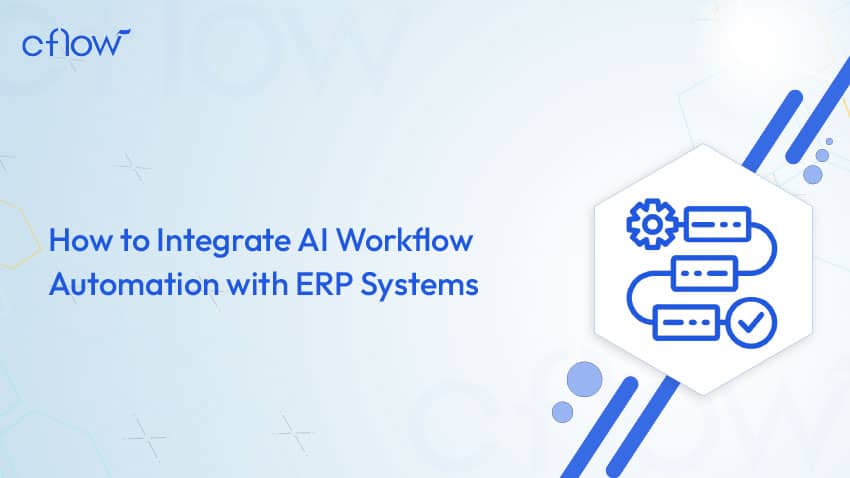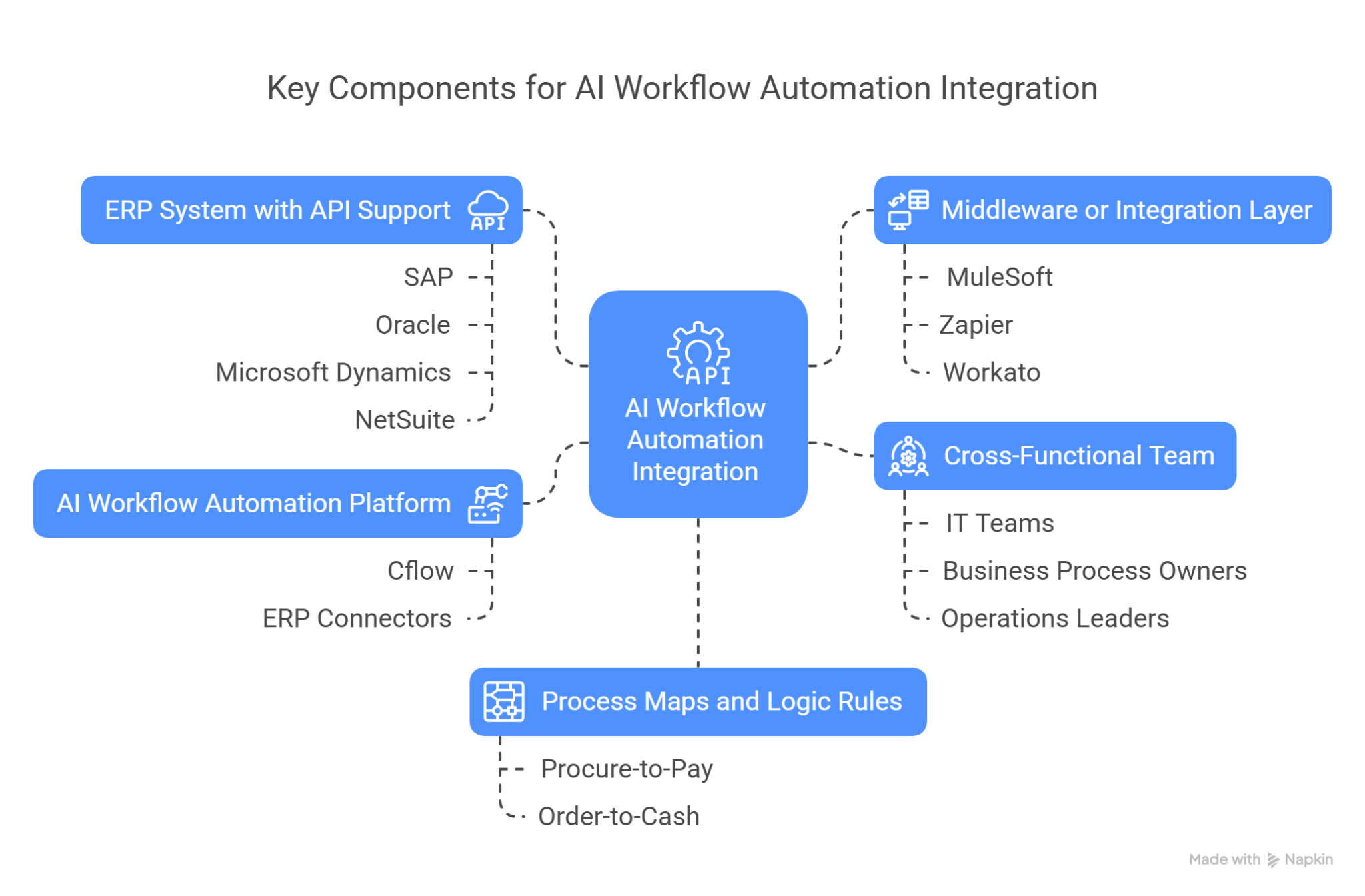How to integrate AI workflow automation with ERP

Key takeaways
- AI workflow automation enhances ERP systems by streamlining repetitive tasks, predicting outcomes, and improving decision-making accuracy.
- Integrating AI with ERP improves data consistency, accelerates core processes, and unlocks real-time operational insights.
- Businesses can leverage no-code platforms or middleware tools to connect AI automation with ERP modules like finance, HR, and supply chain.
- Successful integration requires a clear process blueprint, robust APIs, and cross-functional collaboration across IT and business units.
Why ERP Systems Alone Are No Longer Enough
ERP systems are the backbone of enterprise operations—managing everything from procurement and HR to finance and logistics. Yet, many of these systems still rely on manual data entry, rule-based approvals, and batch processing that slows down business agility.
Enter AI workflow automation: a game-changing layer that brings intelligence, adaptability, and speed to rigid ERP workflows. Whether it’s auto-generating purchase orders based on predictive demand or routing HR requests using natural language processing, AI can supercharge ERP with real-time, data-driven efficiency.
The global AI in ERP market is projected to grow from GBP 3.6 billion in 2023 to GBP 37.2 billion by 2033, reflecting a robust CAGR of 26.3%. This highlights the rapid adoption of AI for automating ERP workflows.
This blog explores how to integrate AI automation into ERP systems—what you need, how it works, and what value it delivers to your business.
What is AI Workflow Automation in the Context of ERP?
AI workflow automation involves using machine learning, natural language processing, and intelligent rules to handle tasks typically managed by humans. In ERP systems, these tasks include invoice approvals, purchase requisition routing, payroll adjustments, inventory updates, and more.
By integrating AI into ERP workflows, businesses can:
- Reduce manual effort and processing time
- Identify anomalies (e.g., duplicate invoices, fraud patterns)
- Trigger actions based on predictive insights
- Ensure data consistency across modules
For example, in a finance module, AI can scan and extract invoice data, match it against POs, flag exceptions, and initiate payments—without human intervention.
Why Integrate AI Workflow Automation with ERP?
ERP systems handle everything from procurement and HR to finance and inventory—but many still rely on manual tasks that slow down execution and limit scalability. By integrating AI-powered workflow automation, companies can move beyond static processes to create intelligent, self-optimising systems that adapt, learn, and scale. This powerful combination delivers real-time insights, faster execution, and operational resilience.
According to a recent study, AI-driven automation can reduce processing time for repetitive ERP tasks (e.g., invoice approvals, data entry) by up to 70%, allowing teams to focus on strategic activities and boosting operational efficiency.
1. Operational Efficiency
AI eliminates repetitive tasks such as manual data entry, status updates, and multi-step approvals. By automating these time-consuming processes, teams can reduce workload, cut operational costs, and focus on higher-value strategic activities.
2. Improved Accuracy
Machine learning models built into AI workflows learn from historical ERP data to refine predictions, reduce manual errors, and detect mismatches across orders, invoices, and inventory. This leads to cleaner data and better decision-making.
3. Real-Time Decision-Making
AI-driven workflows integrate directly with ERP systems to act on live data. Whether it’s alerting teams about stock shortages, flagging invoice anomalies, or routing urgent requests—decisions can be made instantly, without manual intervention.
4. Scalability
As business volumes grow, AI-infused workflows scale effortlessly without adding overhead. ERP systems powered by automation can process thousands of transactions, approvals, and updates with consistent speed and accuracy—regardless of scale.
5. Business Agility
AI workflow automation tools—especially no-code platforms—make it easy to update processes, add rules, or adjust workflows on the fly. This allows businesses to respond faster to market changes, customer demands, and internal shifts.
6. Risk Management and Compliance
AI continuously monitors ERP transactions for policy violations, fraud signals, and regulatory non-compliance. Built-in audit trails and intelligent alerts ensure that every action is documented, traceable, and aligned with governance standards.
Industry Applications of AI Workflow Automation
AI workflow automation isn’t limited to one department or sector—it’s transforming operations across industries. By integrating with ERP systems, businesses can tailor intelligent workflows to address sector-specific challenges, improve responsiveness, and drive operational excellence. Here’s how different industries are leveraging AI-powered automation:
1. Manufacturing
AI-powered workflow automation helps streamline complex production processes. Manufacturers use it to schedule production runs, manage preventive maintenance, and minimise equipment downtime. By integrating with ERP systems, they can automatically adjust schedules based on material availability, machine performance, and demand forecasts.
2. Retail
Retailers use AI to drive real-time pricing updates, automate inventory replenishment, and personalise customer engagement. With ERP-connected workflows, stores can ensure optimal stock levels, react quickly to sales trends, and reduce inventory waste—boosting both revenue and customer satisfaction.
3. Healthcare
Hospitals and clinics benefit from AI workflows that simplify administrative tasks. Claims processing, patient onboarding, appointment scheduling, and document verification become faster and error-free. Integration with healthcare ERPs ensures compliance, accurate data handling, and improved patient experience.
AI workflows integrated with healthcare ERPs reduce claims processing time by 40%, ensuring compliance and improving patient onboarding efficiency.
4. Logistics
In logistics and supply chain management, AI automation supports real-time shipment tracking, load optimisation, and route planning. Workflow automation ensures smoother handoffs, faster dispatching, and proactive exception handling—driving reliability and customer trust.
End-to-end workflow automation
Build fully-customizable, no code process workflows in a jiffy.
Key Components for Integrating AI workflow automation with ERP systems
For the integration to deliver measurable business value, you need the right technology, a well-defined process structure, and strong collaboration across teams.
Here are the core components that make this integration successful:
1. ERP System with API Support
Modern ERP platforms like SAP, Oracle, Microsoft Dynamics, and NetSuite must support API or web service access. This enables real-time communication between the ERP and AI automation platforms, allowing data to flow securely and actions to be triggered without manual intervention.
2. AI Workflow Automation Platform
A no-code AI-powered automation tool like Cflow allows businesses to design, deploy, and manage intelligent workflows. With built-in ERP connectors or API integration capabilities, these platforms bring agility, intelligence, and automation directly into core business processes.
3. Middleware or Integration Layer
Integration tools such as MuleSoft, Zapier, or Workato serve as middleware to connect AI platforms with ERP systems. They help map fields, translate data formats, and automate complex interactions across systems, especially when native integrations don’t exist.
4. Process Maps and Logic Rules
To build intelligent automation, you need a clear understanding of the ERP workflows being automated. Mapping processes like procure-to-pay or order-to-cash allows teams to identify decision points, exceptions, and optimisation opportunities—critical inputs for designing AI logic.
5. Cross-Functional Team
Successful integration goes beyond technology. It requires collaboration between IT teams, business process owners, and operations leaders to align technical feasibility with business outcomes. This ensures that automated workflows are practical, scalable, and truly transformative.
How to Integrate AI Workflow Automation with ERP
Integrating AI automation with your ERP system doesn’t need to be overwhelming. With the right approach, businesses can unlock faster decision-making, reduce manual work, and scale processes effortlessly. Below is a step-by-step roadmap to help you plan, execute, and optimise your AI-ERP integration for maximum impact.
Step 1: Identify High-Impact ERP Workflows
Begin by selecting workflows that are repetitive, time-consuming, and critical to operations—such as invoice approvals, leave requests, purchase orders, or inventory restocking. These areas benefit the most from automation and deliver quick ROI.
Step 2: Map the Existing Workflow
Document the current ERP process in detail. Identify each step, stakeholder, dependency, and decision point. This mapping helps pinpoint bottlenecks and ensures the new AI-driven workflow mirrors real-world needs.
Step 3: Select the Right AI Automation Tool
Choose a no-code platform like Cflow that integrates easily with ERP systems. Look for features such as AI decision logic, rule-based routing, SLA tracking, and visual workflow design—so business teams can build and manage workflows independently.
Step 4: Configure API Integrations
Enable seamless data exchange between ERP and the automation platform using RESTful APIs or prebuilt connectors. This ensures real-time updates for transactions, approvals, and status changes without manual intervention.
Step 5: Design AI Workflows
Incorporate AI capabilities such as natural language processing (NLP) to interpret text fields, machine learning (ML) to detect anomalies, and smart rules to trigger actions based on business logic. These workflows adapt and improve over time, making them more intelligent with use.
Step 6: Test and Optimise
Before full rollout, test the workflow using real scenarios. Validate edge cases, simulate errors, and gather feedback from end users. Fine-tune automation rules to improve accuracy and user experience.
Step 7: Deploy and Monitor
Deploy in stages—starting with a pilot group. Use built-in dashboards to monitor KPIs like processing time, error rates, compliance metrics, and user adoption. Continue refining the workflow for scalability and performance.
IT Readiness and Infrastructure Requirements
Integration success hinges not just on the platform, but also on IT preparedness.
- API Infrastructure: Your ERP must support REST or SOAP APIs. Evaluate latency, security protocols, and data formats.
- Data Normalisation: Ensure consistent data structures across ERP modules for accurate AI input.
- Role-Based Access: Implement access controls to protect sensitive data as automation interacts with HR, finance, and vendor records.
- Testing Environments: A staging environment is critical for testing workflows before live deployment.
Change Management: Ensuring User Adoption and Long-Term Success
- Stakeholder Engagement: Involve end-users and managers early to gather feedback and secure buy-in.
- Training Programs: Offer hands-on workshops and documentation to ease the transition from manual to automated workflows.
- Iterative Rollout: Launch AI workflows in phases to reduce disruption and allow for continuous refinement.
- Support Systems: Establish internal help desks or vendor partnerships to provide post-launch support.
How Cflow Helps with AI Workflow Automation in ERP Integration
Cflow empowers businesses to streamline ERP workflows using AI-driven automation — without writing a single line of code. Whether you’re integrating with SAP, Oracle, or Microsoft Dynamics, Cflow makes the process faster, smarter, and more secure. Here’s how:
Seamless ERP Integration
Cflow integrates with major ERP systems using REST APIs and middleware connectors, enabling real-time, bi-directional data exchange. Workflows can be triggered based on ERP events such as invoice entries, stock updates, or purchase order approvals — eliminating manual handoffs.
AI-Powered Workflow Creation with Seyarc AI
Seyarc AI, Cflow’s built-in AI engine, allows users to build workflows from natural language prompts or process diagrams. It supports smart routing, detects anomalies, and suggests next steps — helping users automate processes faster and with better precision.
No-Code Workflow Customisation
With Cflow’s visual builder, business users can create and update ERP-linked workflows using a simple drag-and-drop interface. Tasks like form creation, role assignments, and approval rules can be configured without IT dependency — enabling rapid deployment.
Live Dashboards & SLA Monitoring
Cflow offers real-time dashboards and SLA tracking to monitor key ERP workflows like procure-to-pay or order-to-cash. Users can instantly identify delays, pending approvals, and compliance risks — and act before issues escalate.
Enterprise-Grade Security & Compliance
Cflow includes role-based access controls, detailed audit trails, and policy-based workflow governance. It helps businesses meet global compliance standards including GDPR, SOC 2, and HIPAA, making it suitable for highly regulated industries.
Conclusion
AI workflow automation is redefining what’s possible for enterprise operations. It brings speed, intelligence, and adaptability to traditional ERP systems—reducing manual effort, improving accuracy, and unlocking real-time insights. By adopting platforms like Cflow, businesses can modernise their ERP workflows, respond faster to change, and scale with confidence.
Start your free trial of Cflow and see how AI-powered workflow automation can transform your ERP-driven processes.
FAQs
1. How do you integrate AI into a workflow?
AI is integrated into workflows by using platforms that support intelligent triggers, decision logic, and data analysis. Tools like Cflow allow you to build AI workflows with NLP, ML, and no-code interfaces.
2. What is AI workflow automation?
AI workflow automation combines automation with artificial intelligence to execute tasks, make decisions, and adapt processes. It reduces manual input and improves accuracy using data-driven logic.
3. What is the role of AI in ERP?
AI enhances ERP systems by automating routine tasks, improving forecasting, and enabling real-time decision-making. It transforms static processes into intelligent, self-optimising workflows.
4. What an is intelligent automated workflow?
An intelligent automated workflow uses AI to understand, adapt, and act on data. Unlike traditional automation, it evolves based on patterns, exceptions, and business context.
5. How to integrate AI into ERP?
AI can be integrated into ERP using APIs, middleware, or platforms like Cflow. This allows real-time data flow, smart approvals, and predictive insights without disrupting existing ERP operations.
What would you like to do next?
Automate your workflows with our Cflow experts.


